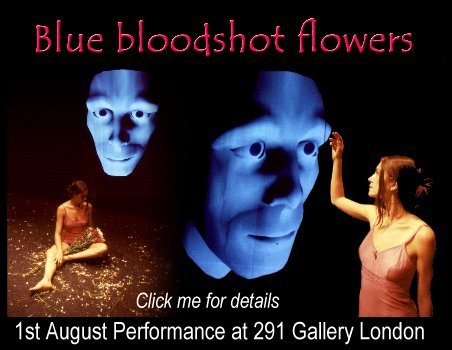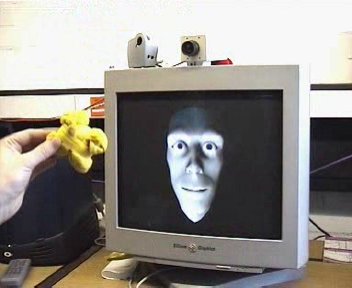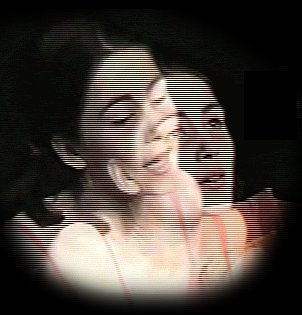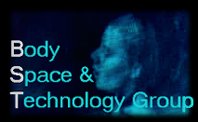| Richard Bowden |
|
Susan Broadhurst Subject Leader |
The cursor on this web-page is a representation of Jeremiah's
face and the eyes randomly appear to blink


|
This is Jeremiah, Jeremiah is a computer generated animated head
based upon Geoface. He has a simple bone structure which allows him to express himself and
emotions with which he can become angry or sad. But most importantly he has eyes with
which he can see. Jeremiah has a visual system which allows him to watch his environment and react to it. Video 1 - 3 demonstrates what Jeremiah sees and what we as an audience see. It also demonstrates the visual surveillance technology and real-time interaction between Jeremiah and Richard Bowden. The Real-Time video clips will not be displayed inless you have this software Download RealPlayer, Download DIV-X Codecs (works with media player). Also they have no sound. Jeremiah watching a yellow duster, Real Player, DIV-X Codec |
|
 |
Elodie: Interaction,
Reaction and Performance
The Human Body Tracking Project
The collaboration involves developing a contemporary performance piece bringing together physical theatre, live art and new technologies. The English/French text used in the work is from an original prose written by Philip Stanier. The production will consist of a public, live performance and will be distributed electronically over the web.
Downloadable movies :Video 5-7 shows Elodie and Jeremiah in rehearsal and how they interact with one another in real-time.
Jeremiah and Elodie interacting on stage Part 1, Real Player
Jeremiah and Elodie interacting on stage Part 2, Real Player
Jeremiah and Elodie interacting on stage Part 3, Real PlayerVideo 8 demonstrates how Jeremiah shares his attention between more than one person - and here Richard and Martin Lewin, a PhD student from Systems Engineering at Brunel and our Stage Manager, compete for Jeremiah's attention.
Jeremiah shares his attention between people, Real PlayerVideo 9 has both the performer Elodie and the director Sue Broadhurst attempting at the same time to cheer Jeremiah up. At the same time demonstrating some of Jeremiah's emotional expressions.
Trying to cheer up Jeremiah, Real PlayerVideo 10 shows Jeremiah's apparent sadness at being left alone
Sad to be left alone, Real PlayerVideo's 11-15 are in Quick-time format and contain sound. They are clips from one of the public performances of Blue Bloodshot Flowers (2001)
Video 11 Richard demonstrates how Jeremiah interacts with audience members, and again Jeremiah does not like to be left alone.
Audience Interaction with Richard, MpegVideo 12 shows various audience members interacting with Jeremiah and trying to make him smile
Audience Interaction, MpegVideo 13 illustrates Jeremiah's Geo-face construction.
Facial Construction, MpegVideo 14-15 shows Elodie and Jeremiah interacting with one another in real-time during one of the public performances.
Hold Hands, Mpeg
We Walked, MpegDownload RealPlayer, Download DIV-X Codecs (works with media player)
Jeremiah was born from a security system
Jeremiahs visual system is actually based upon a system developed for visual surveillance, a system which is designed to watch people and vehicles performing their every day tasks. Waiting for something unusual to happen. Jeremiah has literally 'been born of this technology' and is the emotional face or the automated security guard who watches patiently for something to happen. Imagine now if we gave that system feelings. Boredom when nothing is happening, anger when people leave and he cant, sadness, joy and surprise when finally the event happens that he has been waiting for. This is Jeremiah, but his emotions and interest in the world and people make him more like a child than a computer system.
Now how do you react to Jeremiah, some people find him eerie, some fun, but people always see more in him than he really is. People want to believe he is sentient so they make him as real as they want him to be. Now how do you interact with Jeremiah. You do it naturally. Everything you do effects him, his reactions are directly related to your presence but the chaos of the system means we never know what he will do next. Now how do you perform with Jeremiah, that is what we are trying to establish. Jeremiah is unique in that as effectively a piece of set within a performance he embodies intelligence and is in no way prescripted. The performance is a transaction between performer and technology.
| Scientific Research Rationale | Art Research Rationale |
| The Turing test describes a system as artificially intelligent if a human user cannot distinguish the system from another human in conversation. We are attempting to test this concept of intelligence by providing an interactive human avatar with simple rules and chaotic behaviour. The interactivity and human embodiment of Jeremiah is sufficient that individuals see him as a living entity. | This research takes place within a context of rapidly evolving contemporary performance practices which, as yet have not been adequately theorised. By the term contemporary performance practice, we are indicating those works which utilise a broad range of digital technologies, multimedia, installation and interactivity, together with live art performance. |
| How real can Artificial Life become? How do we interact with A'Life ? | What are the implications of new technologies on contemporary art practices ? |
Some Research Questions
Does the interface between the physical and virtual bodies within contemporary performance practice give rise to a new aesthetics? What are the theoretical and practical implication of this? For instance, such developments as artificial intelligence and motion capture are becoming increasingly prominent in all art practices. One of the aims of the project is to explore and analyse the effect that such technologies have on the physical body in performance. Especially in relation to the problem of re)presenting the 'unrepresentable', that is the sublime of the physical/virtual interface (or liminal space) within new performance practices.
Performance Dates:
For Further details contact:
Dr Richard Bowden, Dept Systems Engineering, Surrey University email website
Dr Susan Broadhurst, BST Group, School of Arts, Brunel University, email.

